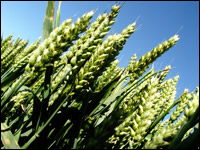So you want to make sure your eating habits are not contributing to global warming, but aren’t ready to go veg. You like the idea of eating only organic food, but worry about the long trek much of it makes to get from producer to grocer. So you’re thinking about consuming only locally produced fare. But is it possible? Well, Alisa Smith and J.B. MacKinnon are giving it a go and sharing their experience with our friends to the north, The Tyee.
In part one, we get the background:
For the average American meal (and we assume the average Canadian meal is similar), World Watch reports that the ingredients typically travel between 2,500 and 4,000 kilometres, a 25 percent increase from 1980 alone. This average meal uses up to 17 times more petroleum products, and increases carbon dioxide emissions by the same amount, compared to an entirely local meal.
Let’s translate that into the ecological footprint model devised by Dr. William Rees of UBC which measures how many planets’-worth of resources would be needed if everyone did the same. If you had an average North American lifestyle in every other way, from driving habits to the size of your house, by switching to a local diet you would save almost an entire planet’s worth of resources (though you’d still be gobbling up seven earths).
As well as the ground rules:
So our rules, when we began, were purist. It was not enough for food to be locally produced (as in bread made by local bakers.) No. Every single ingredient had to come from the earth in our magic 100-mile circle. Our only “out” was that we were allowed to eat occasionally in restaurants or at friends’ houses as we always had, so that we did not have to be social outcasts for a year. And, if we happened to travel elsewhere, we could bring home foods grown within a hundred miles of that new place.
Not surprisingly, our heroes ran into a few problems. Go read the article to learn about their dilemmas, “shrinking butts,” and the beauty of farmers’ markets.
In part two, Alisa and J.B. tackle the issue of breakfast, ponder the merits of their mostly-vegan diet, and share their research on chicken feed:
Does vegetarianism make ecological sense? For more than 15 years, the answer, for us, has been yes. We accepted the now-familiar sustainability formula: on any given tract of agricultural land, it is almost always possible to produce more vegetable foods than animals to eat. Add in the question of cruelty (which seems to increase with every “efficiency” added to animal husbandry), and for us the issue was no contest.
These days, however, we’re asking a new question. Does vegetarianism fit into a local, sustainable diet?
…
Well-meaning friends offered the following advice: “Buy eggs, you idiots!” Sorry, well-meaning friends, but it’s not that easy. Yes, there are local, organic, free-range chickens busy producing local eggs. But what are the chickens eating? The answer, typically, is feed that has traveled the same kinds of distances as most grocery-store products–an average, according to World Watch, of a whopping, globe-warming 2,500 to 4,000 kilometres.
In addition to the authors’ reports, there are many comments, including this gem:
I’m sorry to be a stick-in-the-mud, but the 100 mile diet seems to be the flakiest, most absurd new concept to emerge from the Luddite Left Coast in ages.
Believing ‘the cataclysmic ecological costs of shipping food around the world’ is of concern reveals a thoroughly decadent, pampered filter on one’s outlook. The 100% organic local produce was already delivered on wind powered sailing ships that spread rats, foreign seeds and disease long ago. Smallpox to the East, plague and syphilis to the West and Norwegian rats everywhere.
One would be far more successful sticking to a 100 mile diet in a lush African plain, but it doesn’t seem to work there either as the airdrops and UN convoys will attest.
I will continue to trade trout from my lake for salmon from the ocean or chocolate from Belgium regardless to whether they are delivered by truck or back-packed over the old Grease Trail for two reasons.
So I don’t have to eat the same thing day after day.
Because that’s the way the world works, by things that move. Spices, food, people, money and data.
That may be how the world works, but we have the ability to change that (such as evolving the way cities are built). It is time to change our food production and distribution systems as well.
(More to come, as Alisa and J.B. are expected to write twice a month.)



